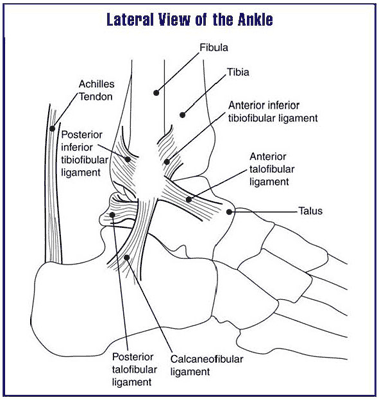Sprained ankle
| Sprained ankle | |
 | |
|---|---|
| Lateral view of the human ankle | |
| ICD-10 | S93.4 |
| ICD-9 | 845.00 |
| DiseasesDB | 726 |
| MedlinePlus | 003167 |
| eMedicine | topic list |
Editor-In-Chief: C. Michael Gibson, M.S., M.D. [1]
A sprained ankle, also known as a ankle sprain, ankle injury or ankle ligament injury, is a common medical condition where one or more of the ligaments of the ankle is torn or partially torn. The anterior talofibular ligament is one of the most commonly involved ligaments. Sprains to the lateral aspect of the ankle account for 85% of ankle sprains.
Causes
A lateral ankle sprain occurs when the ankle is inverted beyond the elastic limits of its supporting structures causing acute ankle pathology.
Treatment
Severe ankle sprains should be assessed by an orthopedic doctor although physical therapy treatment is extremely effective for most sprained ankles. Immediately following the injury it is important the follow the PRICE protocol – protection, rest, ice, compression and elevation (also known as RICE Rest, Ice, compress, elevate).
An ankle brace can be very helpful for the treatment and prevention of a sprained ankle injury. Crutches and air-braces while conventionally used, are currently out of vogue. Complete immobilization is currently the most preferred option among specialists, in the form of the plastic cast also known as a walker. It gives the leg exercise, and yet keeps the damaged part from moving.
See also
External links
- Overview at uchc.edu
- Animated Ankle Sprain
- Rehabilitating Ankle Sprains (Physician and Sportsmedicine, 2002)
- Acute Ankle Sprains (Physician and Sportsmedicine, 2002)
- When to Return to Play After an Ankle Sprain (Physician and Sportsmedicine, 2002)
Template:Medicine-stub Template:Dislocations, sprains and strains